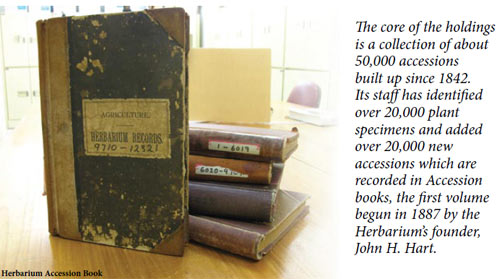 |
 |
 |
|
August 2010
|
The home of botanyBy Yasmin Baksh-Comeau and Christopher Starr
Its geographic mandate is the wider Caribbean, particularly CARICOM and the Eastern Caribbean, although material from T&T predominates in the holdings. The Herbarium is mainly a primary-systematic collection although its high level of curation allowed it to continue in its original role as a reference collection. It includes the cocoa (Theobroma cacao) germplasm collection inherited from the Anglo-Colombian Collecting Expedition of 1953, the only voucher collection of its kind in this hemisphere. Vascular land plants form the bulk of the specimens, with a small but significant collection of lower plants, such as marine algae, mosses and liverworts and a small collection of micro fungi. A study of lichen biodiversity in T&T is in progress to determine its importance in monitoring the state of the environment and climate change. The core of the holdings is a collection of about 50,000 accessions built up since 1842. Its staff has identified over 20,000 plant specimens and added over 20,000 new accessions which are recorded in Accession books, the first volume begun in 1887 by the Herbarium’s founder, John H. Hart. There are now over 70,000 specimens in the Herbarium’s collection; about a third of them have already been digitised as part of an ongoing project for the entire collection. Surveying and inventory work have been going on for a few years to collect and identify the flora on both islands as part of a project to develop a Biodiversity Monitoring System for Trinidad and Tobago.
To find out more about the National Herbarium of Trinidad and Tobago, please see the December 2009 issue of UWI Today Photos: Keisha Manaure |

 The National Herbarium of Trinidad and Tobago was established as a unit of the Royal Botanic Gardens in 1887 to be a repository for a collection of native and introduced plants. At that time the Botanic Gardens played an advisory role in the islands’ agricultural activities, especially in the identification and control of pests and diseases. The decision to locate the Imperial College of Tropical Agriculture (ICTA) in Trinidad in 1922 secured the future of the Herbarium as a research facility. In July 1947, to facilitate expanding botanical research and publication of the Flora of Trinidad and Tobago, the Herbarium was transferred to ICTA in St. Augustine. The collections were held in the Plant Pathology Department until 1953, when the Herbarium was moved to its own purpose-built room in the newly constructed Sir Frank Stockdale building, where it still resides.
The National Herbarium of Trinidad and Tobago was established as a unit of the Royal Botanic Gardens in 1887 to be a repository for a collection of native and introduced plants. At that time the Botanic Gardens played an advisory role in the islands’ agricultural activities, especially in the identification and control of pests and diseases. The decision to locate the Imperial College of Tropical Agriculture (ICTA) in Trinidad in 1922 secured the future of the Herbarium as a research facility. In July 1947, to facilitate expanding botanical research and publication of the Flora of Trinidad and Tobago, the Herbarium was transferred to ICTA in St. Augustine. The collections were held in the Plant Pathology Department until 1953, when the Herbarium was moved to its own purpose-built room in the newly constructed Sir Frank Stockdale building, where it still resides.